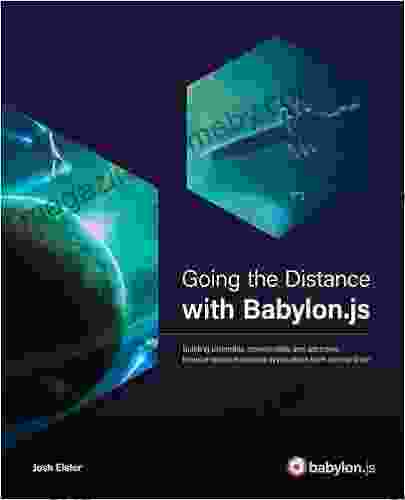Building Extensible, Maintainable, and Attractive Browser-Based Interactive Experiences

In today's digital age, interactive experiences are essential for engaging users and capturing their attention. Browser-based interactive experiences offer a unique opportunity to create immersive and engaging applications that can be accessed from any device with an internet connection. However, building these experiences can be challenging, especially if you want to ensure that they are extensible, maintainable, and attractive.
This comprehensive guide will provide you with everything you need to know about building extensible, maintainable, and attractive browser-based interactive experiences. We will cover topics such as:
- Choosing the right technologies
- Designing for extensibility and maintainability
- Creating beautiful and user-friendly interfaces
- Testing and debugging your experiences
By the end of this guide, you will have the skills and knowledge you need to create engaging and immersive browser-based interactive experiences that will captivate your users.
4.6 out of 5
| Language | : | English |
| File size | : | 2132 KB |
| Text-to-Speech | : | Enabled |
| Print length | : | 816 pages |
| Screen Reader | : | Supported |
The first step in building a browser-based interactive experience is choosing the right technologies. There are a number of different technologies available, each with its own strengths and weaknesses. The best choice for you will depend on the specific needs of your project.
Some of the most popular technologies for building browser-based interactive experiences include:
- HTML5: HTML5 is the latest version of the Hypertext Markup Language. It provides a number of new features that make it ideal for building interactive web applications, such as support for canvas, audio, and video.
- JavaScript: JavaScript is a powerful scripting language that allows you to add interactivity to web pages. It can be used to create dynamic effects, handle user input, and communicate with the server.
- CSS: CSS is a style sheet language that allows you to control the appearance of web pages. It can be used to change the font, color, and layout of elements on the page.
- SVG: SVG is a vector graphics format that is used to create scalable images. SVG images can be resized without losing quality, making them ideal for use in interactive experiences.
In addition to these core technologies, there are a number of other libraries and frameworks that can help you to build interactive experiences. Some of the most popular options include:
- jQuery: jQuery is a JavaScript library that makes it easy to manipulate the DOM and add interactivity to web pages.
- React: React is a JavaScript library that allows you to create reusable components. This can make it easier to build complex interactive experiences.
- Angular: Angular is a JavaScript framework that provides a comprehensive set of tools for building web applications.
When designing your browser-based interactive experience, it is important to keep extensibility and maintainability in mind. This will help you to ensure that your experience can be easily updated and expanded in the future.
Here are a few tips for designing for extensibility and maintainability:
- Use modular design: Divide your experience into smaller, reusable modules. This will make it easier to update and replace individual modules without affecting the rest of the experience.
- Use a consistent coding style: Establish a coding style and stick to it throughout your project. This will make it easier for other developers to understand and maintain your code.
- Document your code: Write clear and concise documentation for your code. This will help other developers to understand what your code does and how it works.
- Test your code regularly: Test your code regularly to ensure that it is working correctly. This will help you to catch bugs early and prevent them from causing problems in the future.
The user interface of your browser-based interactive experience is what users will see and interact with. It is important to create a beautiful and user-friendly interface that is easy to use and navigate.
Here are a few tips for creating beautiful and user-friendly interfaces:
- Use a clean and minimalist design: Avoid using too many colors, fonts, or images. This will help to keep your interface looking clean and uncluttered.
- Use consistent navigation: Make sure that your navigation is consistent throughout your experience. This will help users to find their way around easily.
- Use clear and concise text: Use clear and concise text to label buttons, links, and other elements. This will help users to understand what each element does.
- Test your interface with users: Test your interface with users to get feedback on its usability. This will help you to identify any areas that need improvement.
Once you have built your browser-based interactive experience, it is important to test and debug it thoroughly. This will help you to ensure that it is working correctly and free of bugs.
Here are a few tips for testing and debugging your experiences:
- Use automated testing tools: Use automated testing tools to test your experience for common errors. This can help you to identify bugs quickly and easily.
- Use manual testing: Manually test your experience to ensure that it is working correctly in all scenarios. This will help you to catch any bugs that automated tests may miss.
- Use a debugger: Use a debugger to step through your code and identify the source of any bugs. This can help you to quickly fix bugs and get your experience back up and running.
Building extensible, maintainable, and attractive browser-based interactive experiences can be challenging, but it is also very rewarding. By following the tips in this guide, you can create engaging and immersive experiences that will captivate your users.
Remember to choose the right technologies, design for extensibility and maintainability, create beautiful and user-friendly interfaces, and test and debug your experiences thoroughly. By following these steps, you can create browser-based interactive experiences that will exceed your expectations.
4.6 out of 5
| Language | : | English |
| File size | : | 2132 KB |
| Text-to-Speech | : | Enabled |
| Print length | : | 816 pages |
| Screen Reader | : | Supported |
Do you want to contribute by writing guest posts on this blog?
Please contact us and send us a resume of previous articles that you have written.
 Book
Book Novel
Novel Page
Page Chapter
Chapter Text
Text Story
Story Genre
Genre Reader
Reader Library
Library Paperback
Paperback E-book
E-book Magazine
Magazine Newspaper
Newspaper Paragraph
Paragraph Sentence
Sentence Bookmark
Bookmark Shelf
Shelf Glossary
Glossary Bibliography
Bibliography Foreword
Foreword Preface
Preface Synopsis
Synopsis Annotation
Annotation Footnote
Footnote Manuscript
Manuscript Scroll
Scroll Codex
Codex Tome
Tome Bestseller
Bestseller Classics
Classics Library card
Library card Narrative
Narrative Biography
Biography Autobiography
Autobiography Memoir
Memoir Reference
Reference Encyclopedia
Encyclopedia Jonathan Ross
Jonathan Ross Juilene Osborne Mcknight
Juilene Osborne Mcknight Lynn Rush
Lynn Rush Jonny Steinberg
Jonny Steinberg John S D Eisenhower
John S D Eisenhower Jordan Raynor
Jordan Raynor Laura Jacobsen
Laura Jacobsen Wei Yang Chao
Wei Yang Chao Juan Mata
Juan Mata Joyce Yee
Joyce Yee Jon Taylor
Jon Taylor Jordan Bone
Jordan Bone Sam Horn
Sam Horn Roger Wiens
Roger Wiens Thomas C Foster
Thomas C Foster Sean Michael Wilson
Sean Michael Wilson Randall M Packard
Randall M Packard Shannon Houde
Shannon Houde Roxanne Dunbar Ortiz
Roxanne Dunbar Ortiz Marti Olsen Laney
Marti Olsen Laney
Light bulbAdvertise smarter! Our strategic ad space ensures maximum exposure. Reserve your spot today!

 Anton ChekhovDive into the Enchanting History of the Florida Keys with Our Comprehensive...
Anton ChekhovDive into the Enchanting History of the Florida Keys with Our Comprehensive...
 Efrain PowellRediscover the Enchanting World of Claude Monet: Explore 130 Masterpieces in...
Efrain PowellRediscover the Enchanting World of Claude Monet: Explore 130 Masterpieces in... Greg FosterFollow ·19.1k
Greg FosterFollow ·19.1k Levi PowellFollow ·4.3k
Levi PowellFollow ·4.3k Ernest ClineFollow ·10.5k
Ernest ClineFollow ·10.5k Ivan TurgenevFollow ·15.1k
Ivan TurgenevFollow ·15.1k Jackson HayesFollow ·11.9k
Jackson HayesFollow ·11.9k W.B. YeatsFollow ·9.4k
W.B. YeatsFollow ·9.4k Evan HayesFollow ·10.1k
Evan HayesFollow ·10.1k Herbert CoxFollow ·11.2k
Herbert CoxFollow ·11.2k

 Efrain Powell
Efrain PowellCritical Thinker's Guide to Media Bias and Political...
In a world awash with information, it has...

 Aubrey Blair
Aubrey BlairMurder Is Bad Manners: An Unforgettable English Mystery
Prepare yourself for a captivating literary...

 Luke Blair
Luke BlairDon't Settle For Safe: Embrace Adventure and Live a Life...
<p>In this inspiring and...

 W.H. Auden
W.H. AudenRoblox Codes Dragon Adventures King Legacy All Combat...
Roblox is a massively popular online game...
4.6 out of 5
| Language | : | English |
| File size | : | 2132 KB |
| Text-to-Speech | : | Enabled |
| Print length | : | 816 pages |
| Screen Reader | : | Supported |











